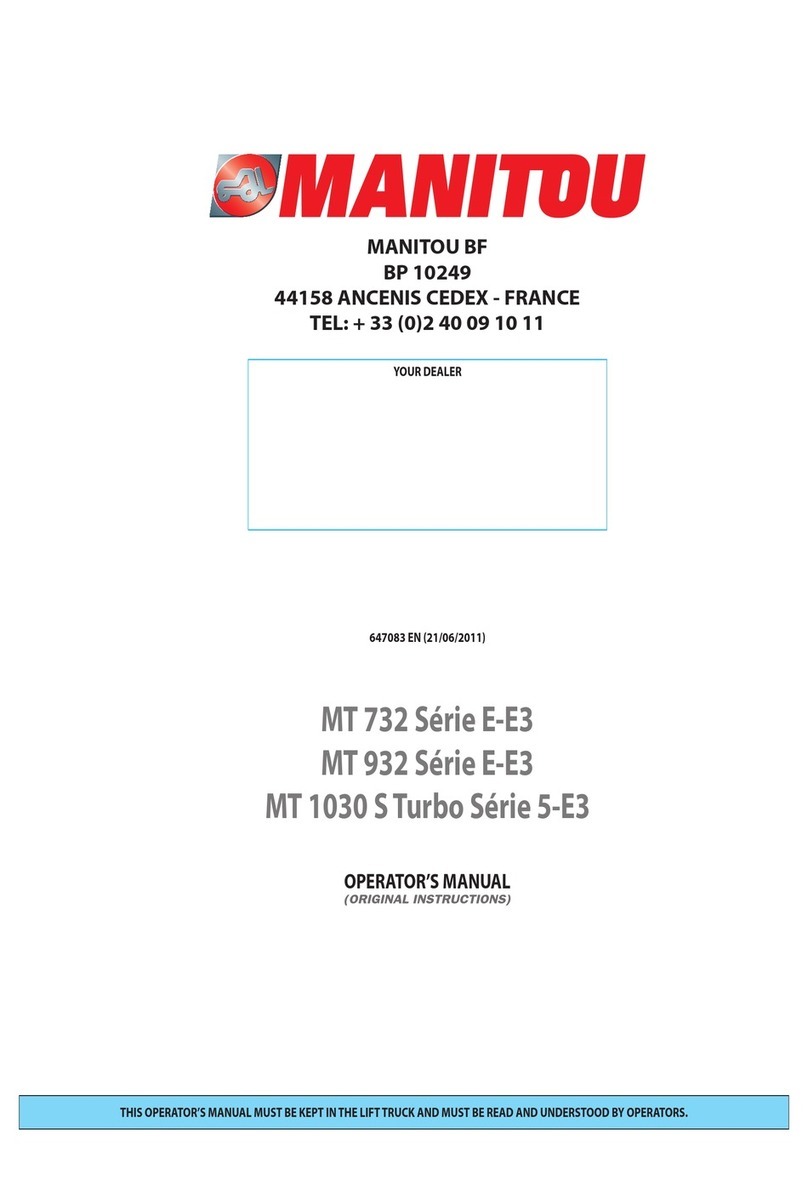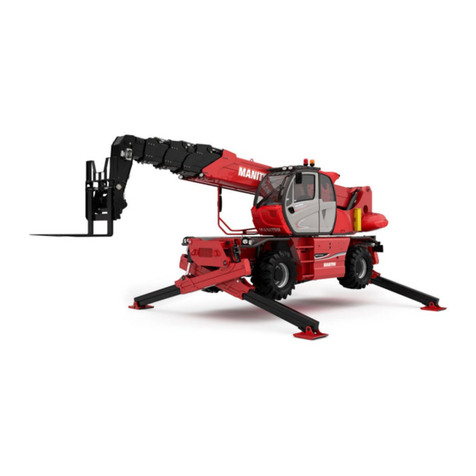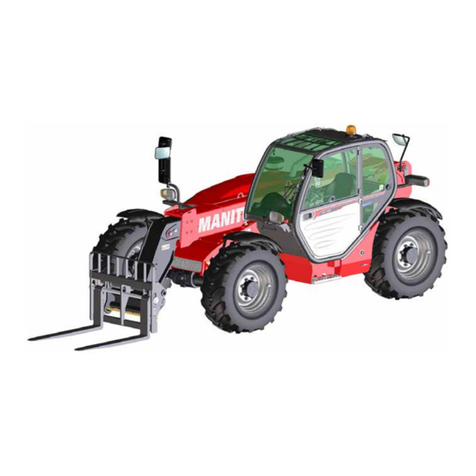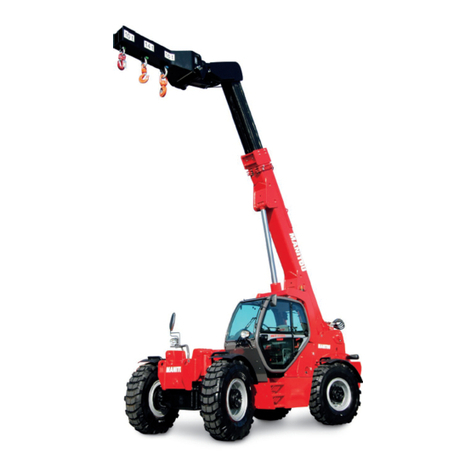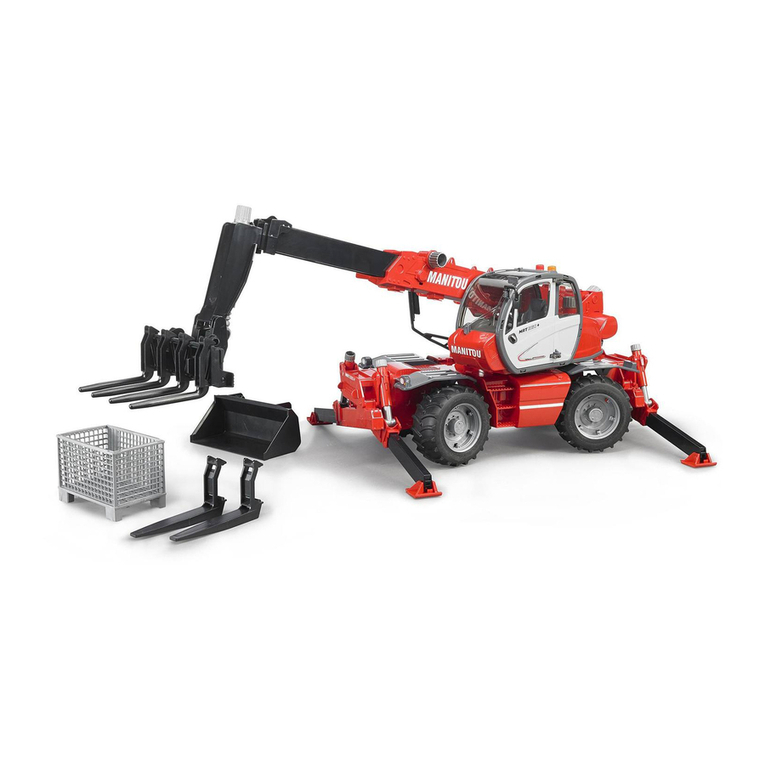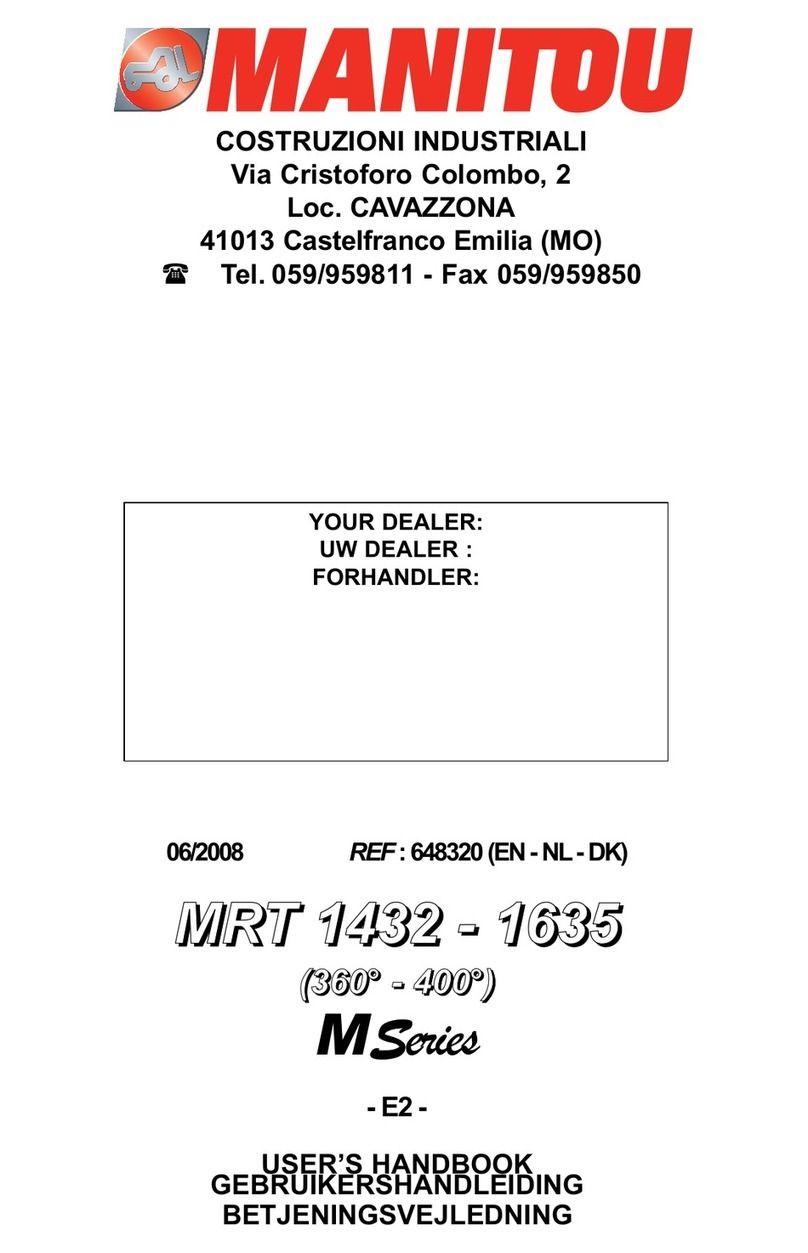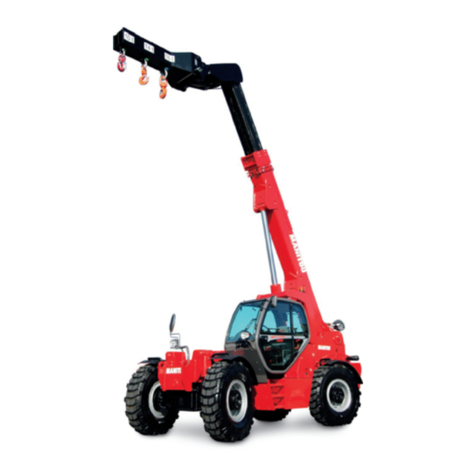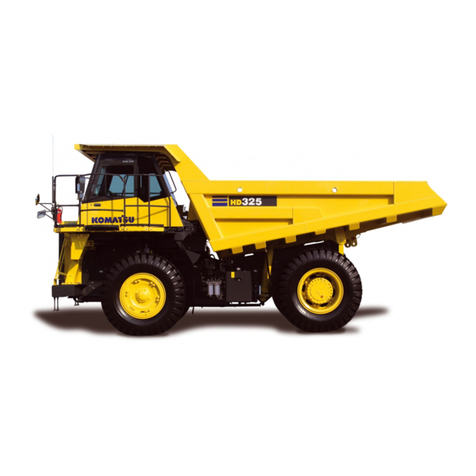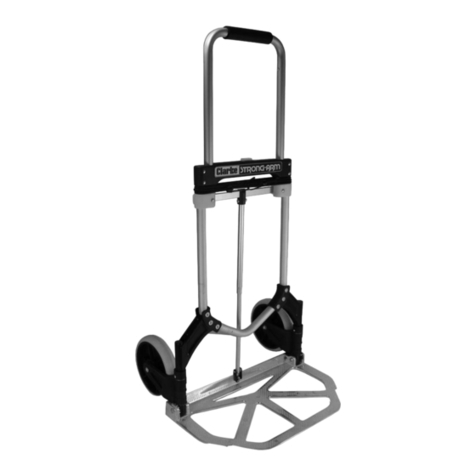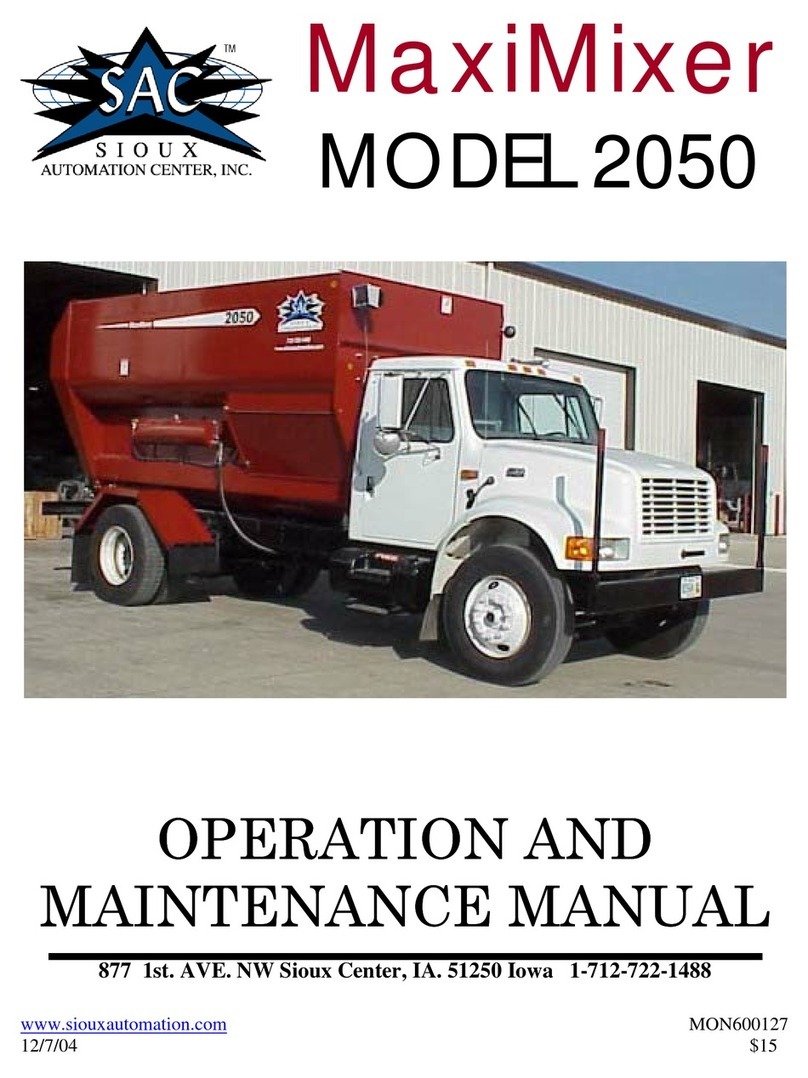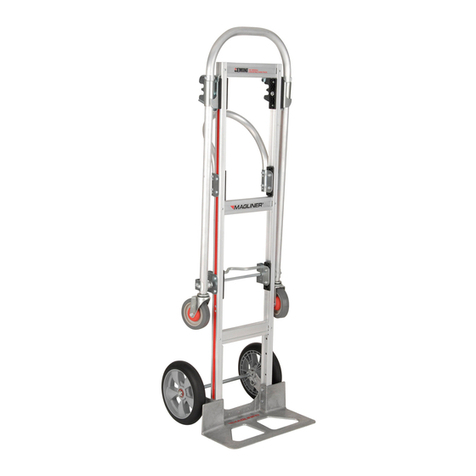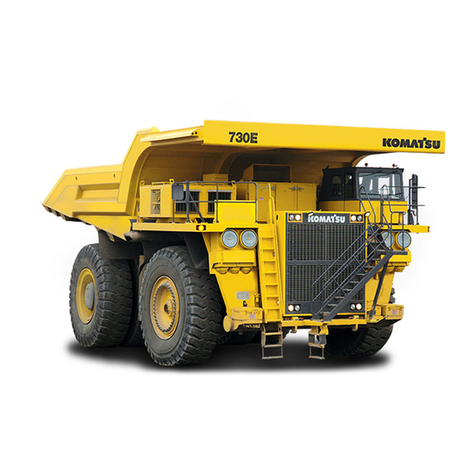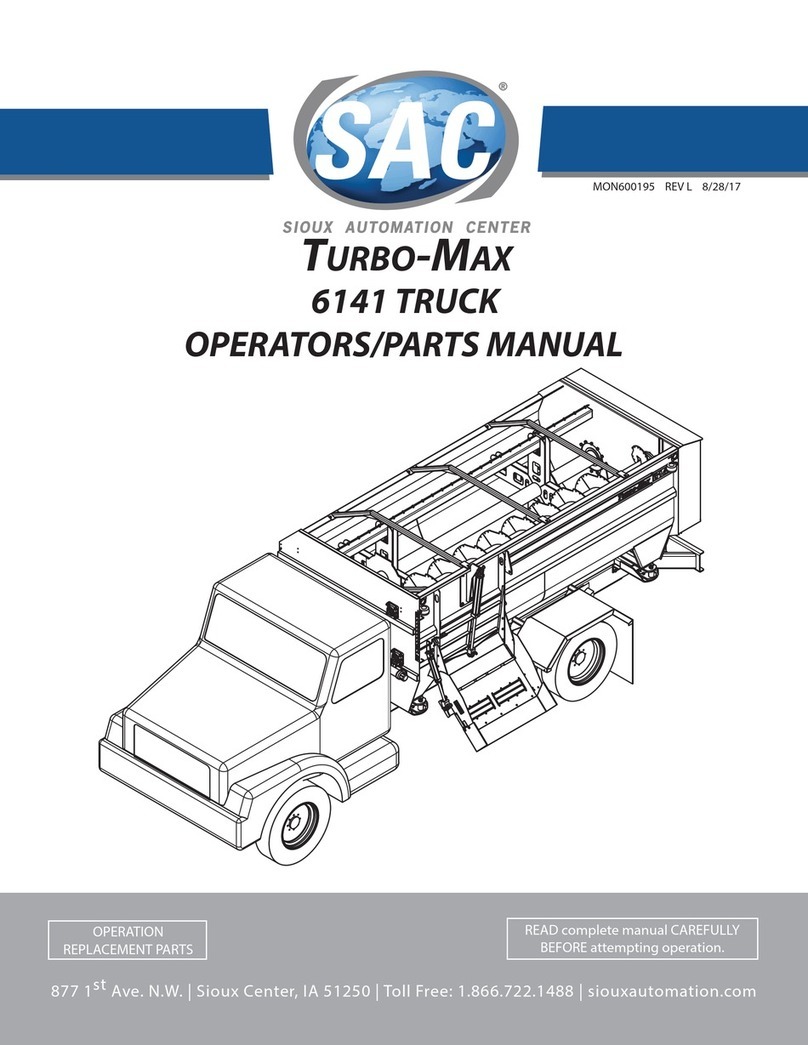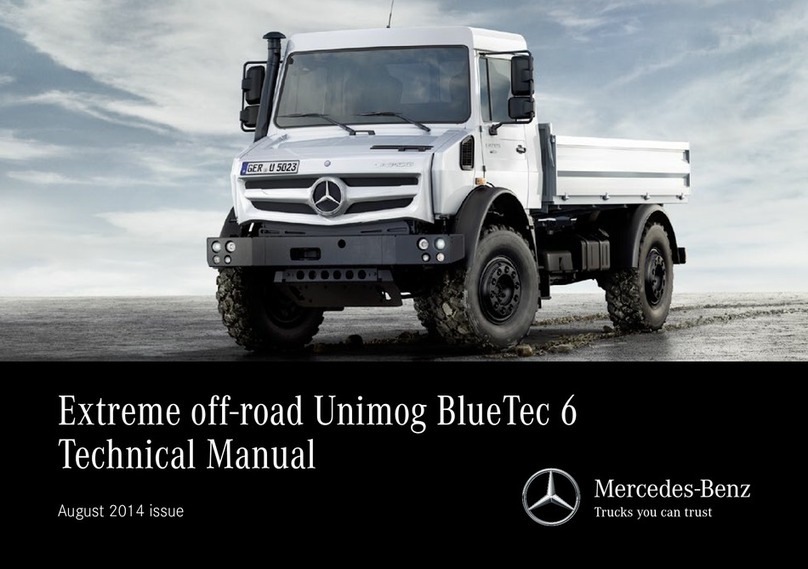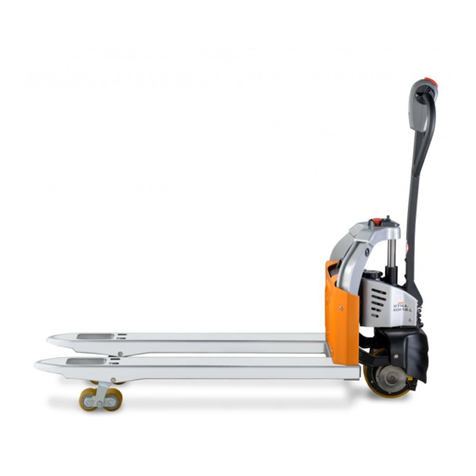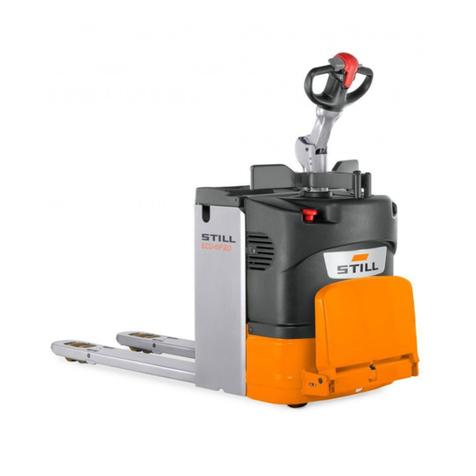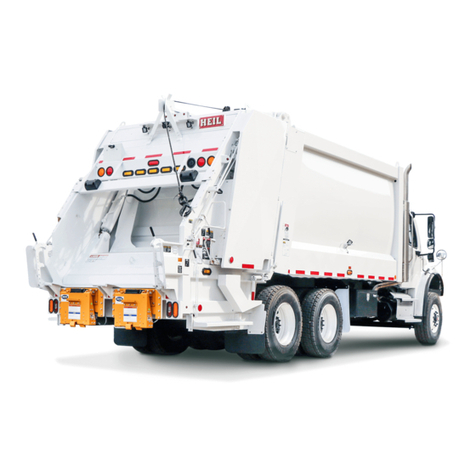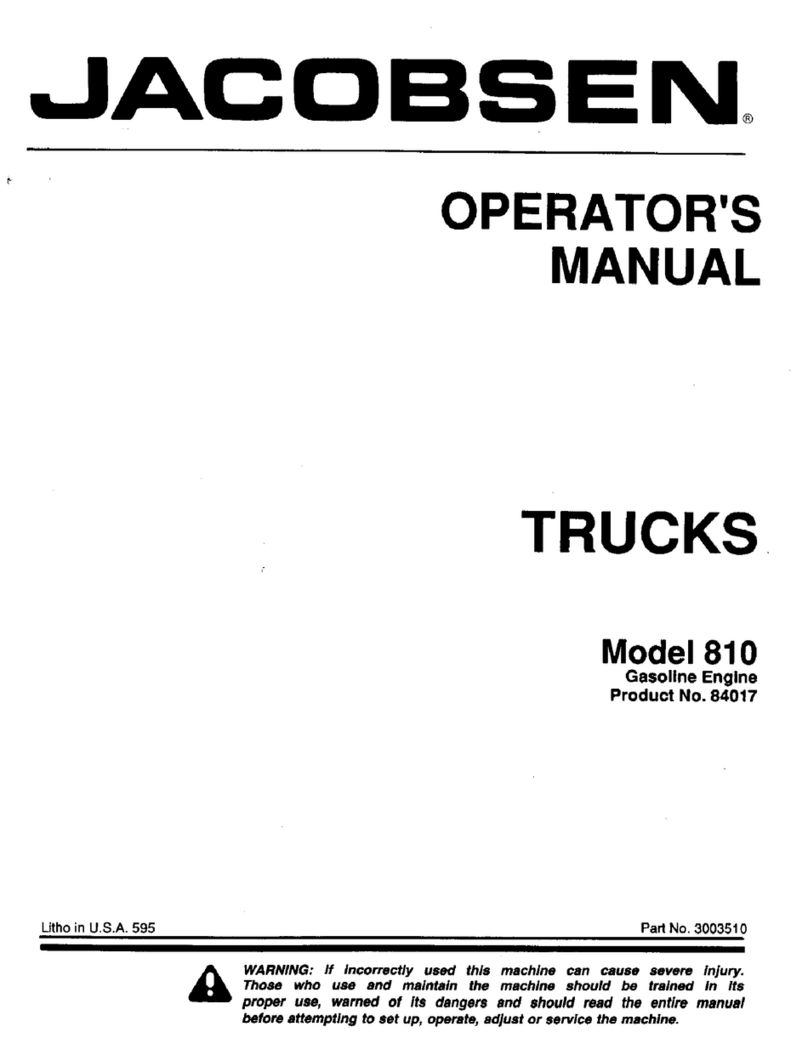Manitou MC 25-2 D K ST3A S1 User manual

OPERATOR'S MANUAL
(ORIGINAL INSTRUCTIONS)
EN (12/12/2017)647635
MC 18-2 D K ST3A S1
MC 18-4 D K ST3A S1
www.duma-rent.com

IMPORTANT
Carefully read and understand this instruction manual before using the lift truck.
It contains all information relating to operation, handling and lift truck equipment,
as well as important recommendations to be followed.
This document also contains precautions for use, as well as information on the servicing and routine maintenance required
to ensure the lift truck's continued safety of use and reliability.
WHENEVER YOU SEE THIS SYMBOL IT MEANS:
IMPORTANT
WARNING ! BE CAREFUL ! YOUR SAFETY OR THE SAFETY OF THE LIFT TRUCK IS AT RISK.
- This manual has been produced on the basis of the equipment list and the technical characteristics
given at the time of its design.
- The level of equipment of the lift truck depends on the options chosen and the country of sale.
- According to the lift truck options and the date of sale, certain items of equipment/functions described
herein may not be available.
- Descriptions and figures are non binding.
- MANITOU reserves the right to change its models and their equipment without being required to
update this manual.
- The MANITOU network, consisting exclusively of qualified professionals, is at your disposal to answer
all your questions.
- This manual is an integral part of the lift truck.
- It is to be kept in its storage space at all times for ease of reference.
- Hand this manual to the new owner if the lift truck is resold.
647635 (12/12/2017)
M
C 18-2 / MC 18-4 ST3A S1
www.duma-rent.com

Manitou BF S.A Limited liability company with a Board of Directors.
Head office: 430, Rue de l’Aubinière - 44150 Ancenis - FRANCE
Share capital: 39,548,949 euros
857 802 508 RCS Nantes.
Tel: +33 (0)2 40 09 10 11
www.manitou.com
This manual is for information purposes only. Any reproduction, copy, representation, recording, transfer, distribution, or other, in part
or in whole, in any format is prohibited. The plans, designs, views, commentaries and instructions, even the document organization
that are found in this document, are the intellectual property of MANITOU BF. Any violation of the aforementioned may lead to civil
and criminal prosecution. The logos as well as the visual identity of the company are the property of MANITOU BF and may not be
used without express and formal authorization. All rights are reserved.
24/07/2017
03/10/2017 2-1 – 2-32
2-25 –> Australian specification
3-1 – 3-38
+ 4 - OPTIONAL ATTACHMENTS FOR USE WITH THE RANGE
12/12/2017 2-28 ; 2-29 ; 2-32
3-12 – 3-36
UPDATED
1st ISSUE
647635 (12/12/2017)
M
C 18-2 / MC 18-4 ST3A S1
www.duma-rent.com

1 - OPERATING AND SAFETY INSTRUCTIONS
2 - DESCRIPTION
3 - MAINTENANCE
4 - OPTIONAL ATTACHMENTS FOR USE WITH THE RANGE
647635 (12/12/2017)
M
C 18-2 / MC 18-4 ST3A S1
www.duma-rent.com

1 - 1
1-OPERATING
AND SAFETY
INSTRUCTIONS
647635 (12/12/2017)
M
C 18-2 / MC 18-4 ST3A S1
www.duma-rent.com

1 - 2
647635 (12/12/2017)
M
C 18-2 / MC 18-4 ST3A S1
www.duma-rent.com

1 - 3
647635 (12/12/2017)
M
C 18-2 / MC 18-4 ST3A S1
www.duma-rent.com

1 - 4
TABLE OF CONTENTS
1 - OPERATING AND SAFETY INSTRUCTIONS
INSTRUCTIONS TO THE COMPANY MANAGER
6
THE SITE 6
THE OPERATOR 6
THE LIFT TRUCK 6
A - THE TRUCK'S SUITABILITY FOR THE JOB . . . . . . . . . . . . . . . . . . . . . . . . . . . . . . . . . . . . . . . . . . . . . . 6
B - ADAPTATION OF THE LIFT TRUCK TO STANDARD ENVIRONMENTAL CONDITIONS . . . . . . . . . . . . . . . . . . . . 6
C - MODIFICATION OF THE LIFT TRUCK . . . . . . . . . . . . . . . . . . . . . . . . . . . . . . . . . . . . . . . . . . . . . . . . . 7
D - FRENCH ROAD TRAFFIC RULES . . . . . . . . . . . . . . . . . . . . . . . . . . . . . . . . . . . . . . . . . . . . . . . . . . . . 7
THE INSTRUCTIONS 7
THE MAINTENANCE 7
INSTRUCTIONS FOR THE OPERATOR
8
PREAMBLE 8
GENERAL INSTRUCTIONS 8
A - OPERATOR'S MANUAL . . . . . . . . . . . . . . . . . . . . . . . . . . . . . . . . . . . . . . . . . . . . . . . . . . . . . . . . . 8
B - AUTHORISATION FOR USE IN FRANCE . . . . . . . . . . . . . . . . . . . . . . . . . . . . . . . . . . . . . . . . . . . . . . . 8
C - MAINTENANCE . . . . . . . . . . . . . . . . . . . . . . . . . . . . . . . . . . . . . . . . . . . . . . . . . . . . . . . . . . . . . . 8
D - MODIFICATION OF THE LIFT TRUCK . . . . . . . . . . . . . . . . . . . . . . . . . . . . . . . . . . . . . . . . . . . . . . . . . 8
E - LIFTING PEOPLE . . . . . . . . . . . . . . . . . . . . . . . . . . . . . . . . . . . . . . . . . . . . . . . . . . . . . . . . . . . . . 8
OPERATING INSTRUCTIONS UNLADEN AND LADEN 9
A - BEFORE STARTING THE LIFT TRUCK . . . . . . . . . . . . . . . . . . . . . . . . . . . . . . . . . . . . . . . . . . . . . . . . . 9
B - DRIVER'S OPERATING INSTRUCTIONS . . . . . . . . . . . . . . . . . . . . . . . . . . . . . . . . . . . . . . . . . . . . . . . . 9
C - ENVIRONMENT . . . . . . . . . . . . . . . . . . . . . . . . . . . . . . . . . . . . . . . . . . . . . . . . . . . . . . . . . . . . . . 9
D - VISIBILITY . . . . . . . . . . . . . . . . . . . . . . . . . . . . . . . . . . . . . . . . . . . . . . . . . . . . . . . . . . . . . . . . 10
E - STARTING THE LIFT TRUCK . . . . . . . . . . . . . . . . . . . . . . . . . . . . . . . . . . . . . . . . . . . . . . . . . . . . . . 10
F - DRIVING THE LIFT TRUCK . . . . . . . . . . . . . . . . . . . . . . . . . . . . . . . . . . . . . . . . . . . . . . . . . . . . . . . 11
G - STOPPING THE LIFT TRUCK . . . . . . . . . . . . . . . . . . . . . . . . . . . . . . . . . . . . . . . . . . . . . . . . . . . . . 12
H - DRIVING THE LIFT TRUCK ON THE PUBLIC HIGHWAY . . . . . . . . . . . . . . . . . . . . . . . . . . . . . . . . . . . . . 12
INSTRUCTIONS FOR HANDLING A LOAD 13
A - CHOICE OF ATTACHMENTS . . . . . . . . . . . . . . . . . . . . . . . . . . . . . . . . . . . . . . . . . . . . . . . . . . . . . 13
B - MASS OF LOAD AND CENTRE OF GRAVITY. . . . . . . . . . . . . . . . . . . . . . . . . . . . . . . . . . . . . . . . . . . . 13
C - TRANSVERSE ATTITUDE OF THE LIFT TRUCK. . . . . . . . . . . . . . . . . . . . . . . . . . . . . . . . . . . . . . . . . . . 13
D - PICKING UP A LOAD ON THE GROUND . . . . . . . . . . . . . . . . . . . . . . . . . . . . . . . . . . . . . . . . . . . . . . 14
E - PICKING UP AND LAYING DOWN A HIGH LOAD ON TIRES . . . . . . . . . . . . . . . . . . . . . . . . . . . . . . . . . . 14
MAINTENANCE INSTRUCTIONS OF THE LIFT TRUCK
16
GENERAL INSTRUCTIONS 16
MAINTENANCE 16
LUBRICANT AND FUEL LEVELS 16
HYDRAULIC 16
ELECTRICITY 16
WELDING 17
WASHING THE LIFT TRUCK 17
TRANSPORTING THE LIFT TRUCK 17
647635 (12/12/2017)
M
C 18-2 / MC 18-4 ST3A S1
www.duma-rent.com

1 - 5
IF THE LIFT TRUCK IS NOT TO BE USED FOR A LONG TIME
18
INTRODUCTION 18
PREPARING THE LIFT TRUCK 18
PROTECTING THE ENGINE 18
PROTECTING THE LIFT TRUCK 18
BRINGING THE LIFT TRUCK BACK INTO SERVICE 18
LIFT TRUCK DISPOSAL
19
RECYCLING OF MATERIALS 19
METALS. . . . . . . . . . . . . . . . . . . . . . . . . . . . . . . . . . . . . . . . . . . . . . . . . . . . . . . . . . . . . . . . . . . . 19
PLASTICS. . . . . . . . . . . . . . . . . . . . . . . . . . . . . . . . . . . . . . . . . . . . . . . . . . . . . . . . . . . . . . . . . . . 19
RUBBER. . . . . . . . . . . . . . . . . . . . . . . . . . . . . . . . . . . . . . . . . . . . . . . . . . . . . . . . . . . . . . . . . . . . 19
GLASS. . . . . . . . . . . . . . . . . . . . . . . . . . . . . . . . . . . . . . . . . . . . . . . . . . . . . . . . . . . . . . . . . . . . . 19
ENVIRONMENTAL PROTECTION 19
WORN OR DAMAGED PARTS . . . . . . . . . . . . . . . . . . . . . . . . . . . . . . . . . . . . . . . . . . . . . . . . . . . . . . 19
USED OIL. . . . . . . . . . . . . . . . . . . . . . . . . . . . . . . . . . . . . . . . . . . . . . . . . . . . . . . . . . . . . . . . . . . 19
USED BATTERIES . . . . . . . . . . . . . . . . . . . . . . . . . . . . . . . . . . . . . . . . . . . . . . . . . . . . . . . . . . . . . . 19
647635 (12/12/2017)
M
C 18-2 / MC 18-4 ST3A S1
www.duma-rent.com

1 - 6
INSTRUCTIONS TO THE COMPANY MANAGER
THE SITE
- Proper management of lift truck's area of travel will reduce the risk of accidents:
• Ground not unnecessarily uneven or obstructed,
• No excessive slopes,
• Pedestrian traffic controlled, etc.
THE OPERATOR
- Only qualified, authorized personnel can use the lift truck. This authorization is given in writing by the appropriate person
in the establishment with respect to the use of lift trucks and must be carried permanently by the operator.
IMPORTANT
On the basis of experience, there are a number of possible situations in which operating the lift truck is contra-indicated. Such foreseeable abnormal uses, the main ones
being listed below, are strictly forbidden.
- The foreseeable abnormal behavior resulting from ordinary neglect, but does not result from any wish to put the machinery to any improper use.
- The reflex reactions of a person in the event of a malfunction, incident, fault, etc. during operation of the lift truck.
- Behavior resulting from application of the “principle of least action” when performing a task.
- For certain machines, the foreseeable behavior of such persons as: apprentices, teenagers, handicapped persons, trainees tempted to drive a lift truck, operator tempted
to operate a truck to win a bet, in competition or for their own personal experience.
The person in charge of the equipment must take these criteria into account when assessing whether or not a person will make a suitable driver.
THE LIFT TRUCK
A - THE TRUCK'S SUITABILITY FOR THE JOB
- MANITOU has ensured that this lift truck is suitable for use under the standard operating conditions defined in this operator's
manual, with a STATIC test coefficient of 1.33 and a DYNAMIC test coefficient of 1, as specified in harmonized norm
EN 1726-1 for mast trucks.
- Before commissioning, the company manager must make sure that the lift truck is appropriate for the work to be done,
and perform certain tests (in accordance with current legislation).
B - ADAPTATION OF THE LIFT TRUCK TO STANDARD ENVIRONMENTAL CONDITIONS
- In addition to series equipment mounted on your lift truck, many options are available, such as: road lighting, stop lights,
revolving light, reverse lights, reverse buzzer alarm, front light, rear light, etc.
- The operator must take into account the operating conditions to define the lift truck's signaling and lighting equipment.
Contact your dealer.
- Take into account climatic and atmospheric conditions of the site of utilization.
• Protection against frost (see: 3 - MAINTENANCE: LUBRICANTS AND FUEL).
• Adaptation of lubricants (ask your dealer for information).
• Engine filtration (see: 3 - MAINTENANCE: FILTERS CARTRIDGES AND BELTS).
IMPORTANT
For operation under average climatic conditions, i.e.: between -15 °C and +35 °C, correct levels of lubricants in all the circuits are checked in production.
For operation under more severe climatic conditions, before starting up, it is necessary to drain all the circuits, then ensure correct levels of lubricants using lubricants
properly suited to the relevant ambient temperatures.
It is the same for the cooling liquid.
- A lift truck operating in an area without fire extinguishing equipment must be equipped with an individual extinguisher.
There are solutions, consult your dealer.
IMPORTANT
Your lift truck is designed for outdoor use under normal atmospheric conditions and indoor use in suitably aerated and ventilated premises.
It is prohibited to use the lift truck in areas where there is a risk of fire or which are potentially explosive (e.g. Refineries, fuel or gas depots, stores of inflammable
products…).
For use in these areas, specific equipment is available (ask your dealer for information).
- Our trucks comply with Directive 2004/108/EC concerning electromagnetic compatibility (EMC), and with the corresponding
harmonized standard EN 12895. Their proper operation is no longer guaranteed if they are used within areas in which
the electromagnetic fields exceed the limit specified by that standard (10 V/m).
- Directive 2002/44/EC requires company managers to not expose their employees to excessive vibration doses. There is
no recognized code of measurement for comparing the machines of different manufacturers. The actual doses received
cannot therefore be measured under actual operating conditions at the user's premises.
647635 (12/12/2017)
M
C 18-2 / MC 18-4 ST3A S1
www.duma-rent.com

1 - 7
- The following are some tips for minimizing these vibration doses:
• Select the most suitable lift truck and attachment for the intended use.
• Adapt the seat adjustment to the operator's weight (according to lift truck model) and maintain it in good condition,
as well as the cab suspension. Inflate the tires in accordance with recommendations.
• Ensure that the operators adapt their operating speed to suit the conditions on site.
• As far as possible, arrange the site in such a way as to provide a flat running surface and remove obstacles and harmful
potholes.
C - MODIFICATION OF THE LIFT TRUCK
- For your own safety and that of others, you must not change the structure and settings of the various components used
in your lift truck by yourself (hydraulic pressure, limiter calibration, engine speed, addition of extra equipment, addition
of counterweights, unapproved attachments, alarm systems, etc.). In this event, the manufacturer cannot be held liable.
D - FRENCH ROAD TRAFFIC RULES
- Only one certificate of conformity is issued. It must be kept in a safe place.
- The driving of non-approved lift trucks on the public highway is subject to the provisions of the highway code relating to
special machines, defined in article R311-1 of the highway code, in category B of the Equipment Order of 20 November
1969 that determines the procedures applicable to special machines. The lift truck must be fitted with a license plate.
THE INSTRUCTIONS
- The operator's manual must always be in good condition and kept in the place provided on the lift truck and in the
language used by the operator.
- The operator's manual and any plates or stickers which are no longer legible or are damaged, must be replaced immediately.
THE MAINTENANCE
- Maintenance or repairs other than those detailed in part: 3 - MAINTENANCE must be carried out by qualified personnel
(consult your dealer) and under the necessary safety conditions to maintain the health of the operator and any third party.
IMPORTANT
Your lift truck must be inspected periodically to ensure that it remains in compliance.
The frequency of this inspection is defined by current legislation in the country in which the lift truck is used.
- Example for France“The manager in charge of the establishment using a lift truck must open and maintain a maintenance
log for each machine (order of 2 March 2004) and undergo a general periodic inspection every 6 months (order of 1March
2004)”.
647635 (12/12/2017)
M
C 18-2 / MC 18-4 ST3A S1
www.duma-rent.com

1 - 8
INSTRUCTIONS FOR THE OPERATOR
PREAMBLE
IMPORTANT
The risk of accident while using, servicing or repairing your lift truck can be restricted if you follow the safety instructions and safety measures detailed in these
instructions.
Failure to respect the safety and operating instructions, or instructions for repairing or servicing your lift truck, may lead to serious, even fatal accident.
In order to reduce or avoid any danger with a MANITOU-approved attachment, follow the instructions of paragraph: 4 - ADAPTABLE ATTACHMENTS IN OPTION ON THE
RANGE: INTRODUCTION.
- Only the operations and maneuvers described in this operator's manual must be performed. The manufacturer cannot
predict all possible risky situations. Consequently, the safety instructions given in the operator's manual and on the lift
truck itself are not exhaustive.
- At any time, as an operator, you must envisage, within reason, the possible risk to yourself, to others or to the lift truck
itself when you use it.
GENERAL INSTRUCTIONS
A - OPERATOR'S MANUAL
- Read the operator's manual carefully.
- The operator's manual must always be in good condition and in the place provided for it on the lift truck.
- You must report any plates and stickers which are no longer legible or which are damaged.
B - AUTHORISATION FOR USE IN FRANCE
(or see current legislation in other countries)
- Only qualified, authorized personnel can use the lift truck. This authorization is given in writing by the appropriate person
in the establishment with respect to the use of lift trucks and must be carried permanently by the operator.
- The operator is not competent to authorize the driving of the lift truck by another person.
C - MAINTENANCE
- The operator must immediately advise his superior if his lift truck is not in good working order or does not comply with
the safety notice.
- The operator is prohibited from carrying out any repairs or adjustments himself, unless he has been trained for this
purpose. He must keep the lift truck properly cleaned if this is among his responsibilities.
- The operator must carry out daily maintenance (see: 3 - MAINTENANCE: A - DAILY OR EVERY 10 HOURS SERVICE).
- The operator must ensure tires are adapted to the nature of the ground (see area of the contact surface of the tires in
the chapter: 2 - DESCRIPTION: TYRES). There are optional solutions, consult your dealer.
• SAND tires.
• LAND tires.
• Snow chains.
IMPORTANT
Do not use the lift truck if the tires are incorrectly inflated, damaged or excessively worn, because this could put your own safety or that of others at risk, or cause damage
to the lift truck itself.
The fitting of foam inflated tires is prohibited and is not guaranteed by the manufacturer, excepting prior authorization.
D - MODIFICATION OF THE LIFT TRUCK
- For your own safety and that of others, you must not change the structure and settings of the various components used
in your lift truck by yourself (hydraulic pressure, limiter calibration, engine speed, addition of extra equipment, addition
of counterweights, unapproved attachments, alarm systems, etc.). In this event, the manufacturer cannot be held liable.
E - LIFTING PEOPLE
- The use of working equipment and load lifting attachments to lift people is:
• Either forbidden
• Or authorized exceptionally and under certain conditions (see current regulations in the country in which the lift
truck is used).
647635 (12/12/2017)
M
C 18-2 / MC 18-4 ST3A S1
www.duma-rent.com

1 - 9
OPERATING INSTRUCTIONS UNLADEN AND LADEN
A - BEFORE STARTING THE LIFT TRUCK
- Perform the daily service (see: 3 - MAINTENANCE: A - DAILY OR EVERY 10 HOURS SERVICE).
- Make sure that the driver's cab is clean, particularly the floor and floor mat. Check that no movable object may hinder
the operation of the lift truck.
- Make sure the lights, indicators and windscreen wipers are working properly.
- Make sure the rear view mirrors are in good condition, clean and properly adjusted.
- Make sure the horn works.
B - DRIVER'S OPERATING INSTRUCTIONS
IMPORTANT
Under no circumstances must the seat be adjusted while the lift truck is moving.
- Whatever his experience, the operator is advised to familiarize himself with the position and operation of all the controls
and instruments before operating the lift truck.
- Wear clothes suited for driving the lift truck, avoid loose clothes.
- Make sure you have the appropriate protective equipment for the task to be performed.
- Prolonged exposure to high noise levels may cause hearing problems. It is recommended to wear ear muffs to protect
against excessive noise.
- Always face the lift truck when getting into and leaving the driving seat and use the handle(s) provided for this purpose.
Do not jump out of the seat to get down.
- Always pay attention when using the lift truck. Do not listen to the radio or music using headphones or earphones.
- Never operate the lift truck when hands or feet are wet or soiled with greasy substances.
- For increased comfort, adjust the seat to your requirements and adopt the correct position in the driver’s cab.
- The operator must always be in his normal position in the driver’s cab. It is prohibited to have arms or legs, or generally
any part of the body, protruding from the driver’s cab of the lift truck.
- The safety belt must be worn and adjusted to the operator's size.
- The control units must never in any event be used for any other than their intended purposes (e.g. climbing onto or down
from the lift truck, portmanteau, etc.).
- If the control components are fitted with a forced operation (lever lock) device, it is forbidden to leave the cab without
first putting these controls in neutral.
- It is prohibited to carry passengers either on the lift truck or in the cab.
C - ENVIRONMENT
- Comply with site safety regulations.
- If you have to use the lift truck in a dark area or at night, make sure it is equipped with working lights.
- During handling operations, make sure that no one is in the way of the lift truck and its load.
- Do not allow anybody to come near the working area of the lift truck or pass beneath an elevated load.
- When using the lift trucks on a transverse slope, before lifting the mast, follow the instructions given in the paragraph:
INSTRUCTIONS FOR HANDLING A LOAD: C - TRANSVERSE ATTITUDE OF THE LIFT TRUCK.
- Travelling on a longitudinal slope:
• Drive and brake gently.
• Moving without load: Forks or attachment facing downhill.
• Moving with load: Forks or attachment facing uphill.
- Take into account the lift truck’s dimensions and its load before trying to negotiate a narrow or low passageway.
- Never move onto a loading platform without having first checked:
• That it is suitably positioned and made fast.
• That the unit to which it is connected (wagon, lorry, etc.) will not shift.
• That this platform is prescribed for the total weight of the lift truck to be loaded.
• That this platform is prescribed for the size of the lift truck.
- Never move onto a foot bridge, floor or freight lift, without being certain that they are prescribed for the weight and size
of the lift truck to be loaded and without having checked that they are in sound working order.
- Be careful in the area of loading bays, trenches, scaffolding, soft ground and manholes.
- Make sure the ground is stable and firm under the wheels before lifting the load.
- Make sure that the scaffolding, loading platform, pilings or ground is capable of bearing the load.
647635 (12/12/2017)
M
C 18-2 / MC 18-4 ST3A S1
www.duma-rent.com

1 - 10
- Never stack loads on uneven ground, they may tip over.
- The load or the attachment must not be left just above a structure for long periods at a time because of the descending
mast. In such a case, a constant watch must be kept and the height of the forks or the attachment readjusted if necessary.
- When working near aerial lines, ensure that the safety distance is sufficient between the working area of the lift truck
and the aerial line.
IMPORTANT
You must consult your local electrical agency.
You could be electrocuted or seriously injured if you operate or park the lift truck too close to power cables.
In the event of high winds, do not carry out handling work that jeopardizes the stability of the lift truck and its load, particularly if the load catches the wind badly.
D - VISIBILITY
- The safety of people within the lift truck's working area, as well as that of the lift truck itself and the operator are depend
on good operator visibility of the lift truck's immediate vicinity in all situations and at all times.
- This lift truck has been designed to allow good operator visibility (direct or indirect by means of rear-view mirrors) of the
immediate vicinity of the lift truck while traveling with no load and with the mast in the transport position.
- Special precautions must be taken if the size of the load restricts visibility towards the front:
• Moving in reverse,
• Site layout,
• Assisted by a person directing the maneuver (while standing outside the truck's area of travel), making sure to keep
this person clearly in view at all times,
• In any event, avoid reversing over long distances.
- If visibility of your road is inadequate, ask someone to assist by directing the maneuver (while standing outside the truck's
area of travel), making sure to keep this person clearly in view at all times.
- Keep all components affecting visibility in a clean, properly adjusted state and in good working order (e.g. windscreens,
windows, windscreen wipers, windscreen washers, driving and work lights, rear-view mirrors).
E - STARTING THE LIFT TRUCK
SAFETY INSTRUCTIONS
IMPORTANT
The lift truck must only be started up or maneuvered when the operator is sitting in the driver’s cab, with his seat belt adjusted and fastened.
- Never try to start the lift truck by pushing or towing it. Such operation may cause severe damage to the transmission.
If necessary, to tow the lift truck in an emergency, the transmission must be placed in the neutral position (see: 3 -
MAINTENANCE: G - OCCASIONAL MAINTENANCE).
- If using an emergency battery for start-up, use a battery with the same characteristics and respect battery polarity when
connecting it. Connect at first the positive terminals before the negative terminals.
IMPORTANT
Failure to respect polarity between batteries can cause serious damage to the electrical circuit.
The electrolyte in the battery may produce an explosive gas. Avoid flames and generation of sparks close to the batteries.
Never disconnect a battery while it is charging.
INSTRUCTIONS
- Check the closing and locking of the hood(s).
- For lift trucks operating on gas carburization, open the gas bottle.
- Ensure that the forward/reverse selector is set to neutral.
- Turn the ignition key to the position I to activate the electrical and pre-heating system.
- Check the fuel level on the indicator.
- Turn the ignition key fully, the engine should then start. Release the ignition key and let the engine run at idle.
- Do not engage the starter motor for more than 15 seconds and carry out the preheating between unsuccessful attempts.
- Make sure all the signal lights on the control instrument panel are off.
- Check all control instruments when the engine is warm and at regular intervals during use, so as to quickly detect any
faults and to be able to correct them without any delay.
- If an instrument does not show the correct display, stop the engine and immediately carry out the necessary operations.
647635 (12/12/2017)
M
C 18-2 / MC 18-4 ST3A S1
www.duma-rent.com

1 - 11
F - DRIVING THE LIFT TRUCK
SAFETY INSTRUCTIONS
IMPORTANT
Operators' attention is drawn to the risks involved in using the lift truck, in particular:
- Risk of losing control.
- Risk of losing lateral and frontal stability of the lift truck.
The operator must remain in control of the lift truck.
In the event of the lift truck overturning, do not try to leave the cabin during the incident.
YOUR BEST PROTECTION IS TO STAY FASTENED IN THE CABIN.
- Observe the company’s traffic regulations or, by default, the public highway code.
- Do not carry out operations which exceed the capacities of your lift truck or attachments.
- Always drive the lift truck with the forks or attachment to the transport position, i.e. at 300mm from the ground and the
carriage sloping backwards.
- Only carry loads which are balanced and properly anchored to avoid any risk of a load falling off.
- Ensure that palettes, cases, etc., are in good order and suitable for the load to be lifted.
- Familiarize yourself with the lift truck on the terrain where it will be used.
- Ensure that the service brakes are working properly.
- The loaded lift truck must not travel at speeds in excess of 12km/h.
- Drive smoothly at an appropriate speed for the operating conditions (land configuration, load on the lift truck).
- Do not use the hydraulic mast controls when the lift truck is moving.
- Do not maneuver the lift truck with the mast in the raised position unless under exceptional circumstances and then
with extreme caution, at very low speed and using gentle braking. Ensure that visibility is adequate.
- Take bends slowly.
- In all circumstances make sure you are in control of your speed.
- On damp, slippery or uneven terrain, drive slowly.
- Brake gently, never abruptly.
- Only use the lift truck’s forward/reverse selector from a stationary position and never do so abruptly.
- Do not drive with your foot on the brake pedal.
- Always remember that hydrostatic type steering is extremely sensitive to movement of the steering wheel, so turn it
gently and not jerkily.
- Never leave the I.C. engine on when the lift truck is unattended.
- Do not leave the cab when the lift truck has a raised load.
- Look where you are going and always make sure you have good visibility along the route.
- Use the rear-view mirrors frequently.
- Drive round obstacles.
- Never drive on the edge of a ditch or steep slope.
- It is dangerous to use two lift trucks simultaneously to handle heavy or voluminous loads, since this operation requires
particular precautions to be taken. It must only be used exceptionally and after risk analysis.
- The ignition switch has an emergency stop mechanism in case of an operating anomaly occurring in the case of lift trucks
not fitted with a punch-operated cut-out.
INSTRUCTIONS
- Always drive the lift truck with the forks or attachment to the transport position, i.e. at 300mm from the ground and the
carriage sloping backwards.
- For lift trucks with gearboxes, select the chosen gear (see: 2 - DESCRIPTION: INSTRUMENTS AND CONTROLS).
- Release the hand brake.
- Shift the forward/reverse selector to the selected direction of travel and accelerate gradually until the lift truck moves off.
647635 (12/12/2017)
M
C 18-2 / MC 18-4 ST3A S1
www.duma-rent.com

1 - 12
G - STOPPING THE LIFT TRUCK
SAFETY INSTRUCTIONS
- Never leave the ignition key in the lift truck during the operator's absence.
- When the lift truck is stationary, or if the operator has to leave his cab (even for a moment), place the forks or attachment
on the ground, apply the parking brake and place the forward/reverse selector in neutral.
- Make sure that the lift truck is not stopped in any position that will interfere with the traffic flow and at less than one
meter from the track of a railway.
- In the event of prolonged parking on a site, protect the lift truck from bad weather, particularly from frost (check the
level of antifreeze), close and lock all the lift truck accesses (doors, windows, cowls, etc.).
INSTRUCTIONS
- Park the lift truck on flat ground or on an incline lower than 15%.
- Set the forward/reverse selector to neutral.
- Engage the parking brake.
- For lift trucks with gearboxes, place the gear lever in neutral.
- Lower the forks or attachment to rest on the ground.
- When using an attachment with a grab or jaws, or a bucket with hydraulic opening, close the attachment fully.
- Before stopping the lift truck after a long working period, leave the I.C. engine idling for a few moments, to allow the
coolant liquid and oil to lower the temperature of the I.C. engine and transmission. Do not forget this precaution, in the
event of frequent stops or warm stalling of the I.C. engine, or else the temperature of certain parts will rise significantly
due to the stopping of the cooling system, with the risk of badly damaging such parts.
- Stop the engine with the ignition switch.
- Remove the ignition key.
- Lock all the accesses to the lift truck (doors, windows, cowls…).
- For lift trucks operating on gas carburization, shut the LPG bottle. For a long lasting stop, let the engine stop naturally by
shutting the LPG bottle before switching off the ignition, so as to eliminate all the fuel in the feed tube.
H - DRIVING THE LIFT TRUCK ON THE PUBLIC HIGHWAY
FRENCH ROAD TRAFFIC RULES
- The driving of non-approved lift trucks on the public highway is subject to the provisions of the highway code relating to
special machines, defined in article R311-1 of the highway code, in category B of the Equipment Order of 20 November
1969 that determines the procedures applicable to special machines. The lift truck must be fitted with a license plate.
SAFETY INSTRUCTIONS
- Operators driving on the public highway must comply with current highway code legislation.
- The lift truck must comply with current road legislation. If necessary, there are optional solutions. Contact your dealer.
INSTRUCTIONS
- Make sure the revolving light is in place, switch it on and verify its operation.
- Make sure the lights, indicators and windscreen wipers are working properly.
- Switch off the working headlights if the lift truck is fitted with them.
- Place the attachment 300mm from the ground.
IMPORTANT
Never move in neutral (forward/reverse selector or gear lever in neutral or transmission cut-off button pressed) to preserve the lift truck engine brake.
Failure to respect this instruction on a slope will lead to excessive speed which may make the lift truck uncontrollable (steering, brakes) and cause serious mechanical
damage.
DRIVING THE LIFT TRUCK WITH A FRONT-MOUNTED ATTACHMENT
- You must comply with current regulations in your country, covering the possibility of driving on the public highway with
a front-mounted attachment on your lift truck.
- If road legislation in your country authorizes circulation with a front-mounted attachment, you must at least:
• Protect and report any sharp and/or dangerous edges on the attachment (see: 4 - ADAPTABLE ATTACHMENTS IN
OPTION ON THE RANGE: ATTACHMENT SHIELDS).
• The attachment must not be loaded.
• Make sure that the attachment does not mask the lighting range of the forward lights.
• Make sure that current legislation in your country does not require other obligations.
647635 (12/12/2017)
M
C 18-2 / MC 18-4 ST3A S1
www.duma-rent.com

1 - 13
For lift trucks equipped with a towing system
OPERATING THE LIFT TRUCK WITH A TRAILER
- For using a trailer, observe the regulations in force in your country (maximum travel speed, braking, maximum weight
of trailer, etc.).
- Do not forget to connect the trailer’s electrical equipment to that of the lift truck.
- The trailer's braking system must comply with current legislation.
- If pulling a trailer with assisted braking, the tractor lift truck must be equipped with a trailer braking mechanism. In this
case, do not forget to connect the trailer braking equipment to the lift truck.
- The vertical force on the towing hook must not exceed the maximum authorized by the manufacturer (consult the
manufacturer’s plate on your lift truck).
- The authorized gross vehicle weight must not exceed the maximum weight authorized by the manufacturer (consult
the manufacturer’s plate on your lift truck).
IF NECESSARY, CONSULT YOUR DEALER.
INSTRUCTIONS FOR HANDLING A LOAD
A - CHOICE OF ATTACHMENTS
- Only attachments approved by MANITOU can be used on its lift trucks.
- Make sure the attachment is appropriate for the work to be done (see: 4 - ADAPTABLE ATTACHMENTS IN OPTION ON
THE RANGE).
- Make sure the attachment is correctly installed and locked onto the lift truck carriage.
- Make sure that your lift truck attachments work properly.
- Comply with the load chart limits for the lift truck for the attachment used.
- Do not exceed the rated capacity of the attachment.
- Never lift a load in a sling without the attachment provided for the purpose. There are optional solutions; contact your
dealer.
B - MASS OF LOAD AND CENTRE OF GRAVITY
- Before taking up a load, you must know its mass and its center of gravity.
- The load chart for your lift truck is valid for a load in which the longitudinal position
of the center of gravity is 500mm or 600mm from the base of the forks (according
to the model of lift truck) (fig. B1). For a higher center of gravity, contact your dealer.
- For irregular loads, determine the transverse center of gravity before any movement
(fig. B2) and set it in the longitudinal axis of the lift truck.
IMPORTANT
It is forbidden to move a load heavier than the effective capacity defined on the lift truck load chart.
For loads with a moving center of gravity (e.g. liquids), take account of the variations in the center of gravity in order
to determine the load to be handled and be vigilant and take extra care to limit these variations as far as possible.
500 mm
B1
B2
C - TRANSVERSE ATTITUDE OF THE LIFT TRUCK.
The transverse attitude is the transverse slope of the chassis with respect to the horizontal.
Raising the mast reduces the lift truck's lateral stability. The transverse attitude must be set with the mast in down position
as follows:
- Position the lift truck so that the bubble in the level is between the two lines (see: 2 - DESCRIPTION: INSTRUMENTS AND
CONTROLS).
647635 (12/12/2017)
M
C 18-2 / MC 18-4 ST3A S1
www.duma-rent.com

1 - 14
E - PICKING UP AND LAYING DOWN A HIGH LOAD ON TIRES
IMPORTANT
You must not raise the mast if you have not checked the transverse attitude of the lift truck
(see: INSTRUCTIONS FOR HANDLING A LOAD: C - TRANSVERSE ATTITUDE OF THE LIFT TRUCK).
REMINDER: Make sure that the following operations can be performed with good
visibility (see: OPERATIONS INSTRUCTIONS UNLADEN AND LADEN:
D- VISIBILITY).
PICKING UP A HIGH LOAD ON TIRES
- Ensure that the forks will easily pass under the load.
- Keeping the mast vertical (1), advance the lift truck and raise the forks to level with
the load (2) (fig. E1).
- Maneuver carefully and gently to bring the forks to the stop in front of the load
(fig.E2). Set the handbrake and place the forward/reverse selector to neutral.
FOR A NON-PALLETISED LOAD
- Tilt the carriage (1) forwards and move the lift truck slowly forwards (2), to insert
the fork under the load (fig. D4) (block the load if necessary).
- Continue to move the lift truck forwards (2) tilting the carriage (3) (fig. D4) backwards
to position the load on the forks and check the load's longitudinal and lateral stability.
D - PICKING UP A LOAD ON THE GROUND
- Approach the lift truck perpendicular to the load, with the forks in a horizontal
position (fig. D1).
- Adjust the spread and centering of the forks relative to the load to ensure its stability
(fig. D2) (optional solutions exist, consult your dealer).
- Never lift a load with a single fork.
IMPORTANT
Beware of the risks of trapping or crushing limbs when manually adjusting the forks.
- Move the lift truck forward slowly (1) and bring the forks to stop in front of the load
(fig. D3), if necessary, slightly lift the mast (2) while taking up the load.
- Bring the load into the transport position.
- Tilt the load far enough backwards to ensure stability (loss of load on braking or
going downhill).
3
1
2
D4
1
2
E1
E2
D1
1
2
D3
D2
647635 (12/12/2017)
M
C 18-2 / MC 18-4 ST3A S1
www.duma-rent.com

1 - 15
- Slightly lift the load (1) and incline the carriage (2) backwards to stabilize the load
(fig. E3).
- Tilt the load sufficiently backwards to ensure its stability.
- Reverse the lift truck (1) very carefully and gently to free the load. Lower the mast
(2) to bring the load into transport position (fig. E4).
LAYING A HIGH LOAD ON TYRES
- Approach the load in the transport position in front of the pile (fig. E5).
- Raise the mast (1) until the load is higher than the pile and move the lift truck
forward (2) (fig. E6) very carefully and gently, until the load is over the pile. Put the
handbrake on and set the forward/reverse selector to neutral.
- Place the load in a horizontal position by tilting the mast forwards (1) and lay it
down on the pile (2) while checking the correct positioning of the load (fig. E7).
- Reverse the lift truck (1) very slowly and carefully to release the forks (fig. E8).Then
set them into transport position.
1
2
E3
1
2
E4
1
2
E7
E5
2
1
E6
1
E8
647635 (12/12/2017)
M
C 18-2 / MC 18-4 ST3A S1
www.duma-rent.com

1 - 16
MAINTENANCE INSTRUCTIONS OF THE LIFT TRUCK
GENERAL INSTRUCTIONS
- Ensure the area is sufficiently ventilated before starting the lift truck.
- Wear clothes suitable for the maintenance of the lift truck, avoid wearing jeweler and loose clothes. Tie and protect your
hair, if necessary.
- Stop the engine and remove the ignition key, when an intervention is necessary.
- Read the operator's manual carefully.
- Carry out all repairs immediately, even if the repairs concerned are minor.
- Repair all leaks immediately, even if the leak concerned is minor.
- Make sure that the disposal of process materials and of spare parts is carried out in total safety and in an ecological way.
- Be careful of the risk of burning and splashing (exhaust, radiator, engine, etc.).
MAINTENANCE
- Perform the periodic service (see: 3 - MAINTENANCE) to keep your lift truck in good working conditions. Failure to perform
the periodic service may cancel the contractual guarantee.
MAINTENANCE LOGBOOK
- The maintenance operations carried out in accordance with the recommendations given in part: 3 - MAINTENANCE and
the other inspection, servicing or repair operations or modifications performed on the lift truck or its attachments shall
be recorded in a maintenance logbook. The entry for each operation shall include details of the date of the works, the
names of the individuals or companies having performed them, the type of operation and its frequency, if applicable.
The part numbers of any lift truck items replaced shall also be indicated.
LUBRICANT AND FUEL LEVELS
- Use the recommended lubricants (never use contaminated lubricants).
- Do not fill the fuel tank when the engine is running.
- Only fill up the fuel tank in areas specified for this purpose.
- Do not fill the fuel tank to the maximum level.
- Do not smoke or approach the lift truck with a flame, when the fuel tank is open or is being filled.
HYDRAULIC
- Any work on the load handling hydraulic circuit is forbidden except for the operations described in part: 3 - MAINTENANCE.
- Do not attempt to loosen couplings, hoses or any hydraulic component with the circuit under pressure.
IMPORTANT
It is dangerous to change the setting and remove the BALANCING VALVES or SAFETY VALVES which may be fitted to your lift truck cylinders.
The HYDRAULIC ACCUMULATORS that may be fitted on your lift truck are pressurized units.
Removing these accumulators and their pipework is dangerous.
Such operations must only be performed by approved personnel (consult your dealer).
ELECTRICITY
- Do not short-circuit the starter relay to start the engine. If the forward/reverse selector is not in neutral and the parking
brake is not applied, the lift truck may suddenly start to move.
- Do not place metal items on the battery.
- Disconnect the battery before working on the electrical circuit.
647635 (12/12/2017)
M
C 18-2 / MC 18-4 ST3A S1
www.duma-rent.com
Other manuals for MC 25-2 D K ST3A S1
1
This manual suits for next models
1
Table of contents
Other Manitou Truck manuals
